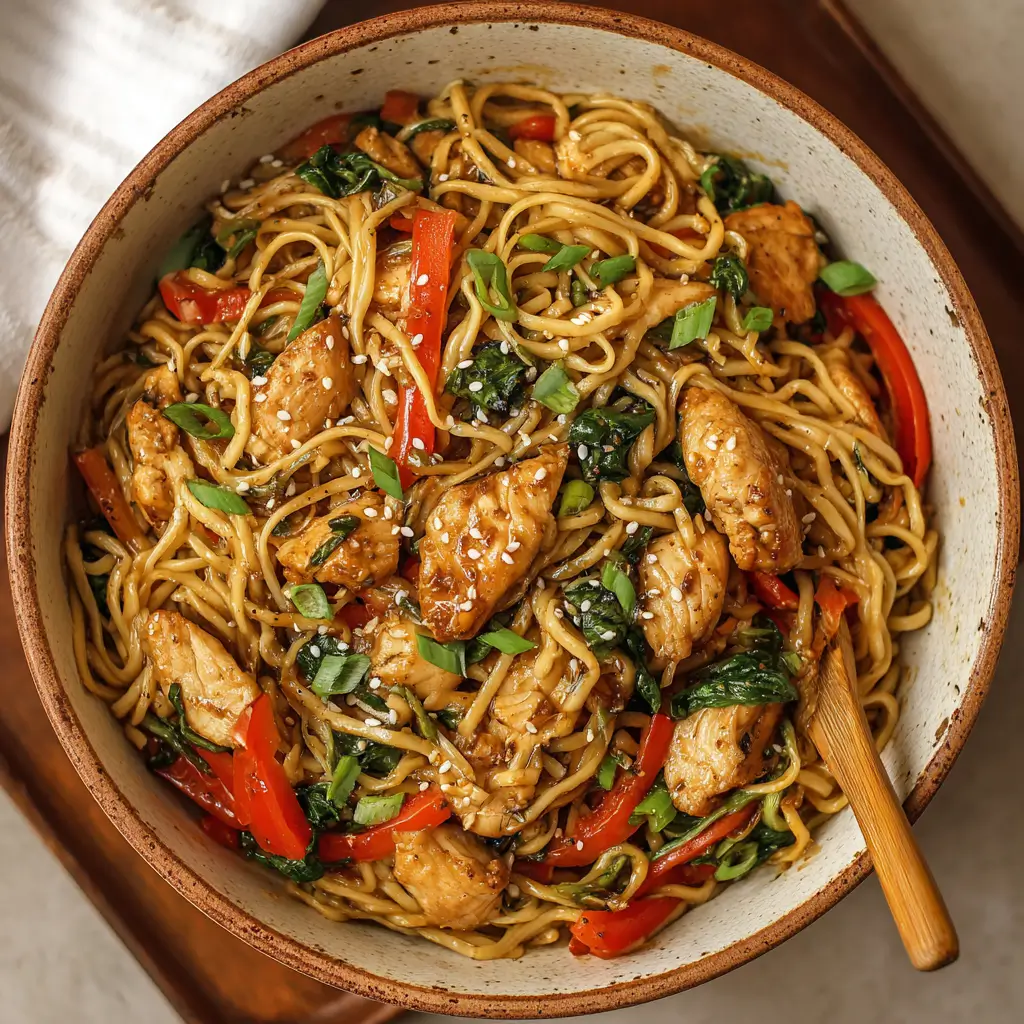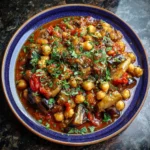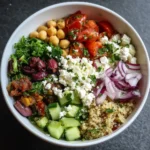Introduction
Sesame Ginger Chicken Noodles are a vibrant, aromatic dish that brings together the bold flavors of Asia in a comforting, satisfying meal. This recipe combines tender chicken, fresh vegetables, and springy noodles tossed in a rich, savory-sweet sauce infused with sesame oil, ginger, garlic, and soy. Whether you’re looking for a quick weeknight dinner or a flavorful way to use up leftover chicken, this dish delivers on taste, texture, and nutrition. With its balance of umami, heat, and freshness, Sesame Ginger Chicken Noodles have become a favorite among home cooks and food lovers alike.
The History
The roots of Sesame Ginger Chicken Noodles trace back to East Asian culinary traditions, particularly Chinese and Japanese cuisines, where noodles and sauces flavored with sesame and ginger have been staples for centuries. In ancient China, noodles were often served during festivals and celebrations, symbolizing longevity. The use of ginger in cooking dates back over 5,000 years and was prized not only for its pungent flavor but also for its medicinal properties. Sesame oil, extracted from toasted sesame seeds, became a cornerstone of Asian flavor profiles due to its deep nuttiness and ability to enhance savory dishes.
As trade routes expanded and culinary techniques evolved, variations of noodle dishes incorporating ginger, garlic, and sesame spread across regions. In Japan, soba and udon noodles were commonly paired with similar flavor bases, while in Korea, jjajangmyeon introduced fermented black bean sauces with sesame undertones. Over time, fusion cuisine—especially in North America—gave rise to modern interpretations like Sesame Ginger Chicken Noodles, blending traditional Asian ingredients with Western cooking styles. Today, this dish is celebrated in restaurants and homes worldwide as a perfect example of global comfort food.
Ingredients Breakdown
The magic of Sesame Ginger Chicken Noodles lies in its harmonious blend of ingredients, each playing a vital role in building layers of flavor and texture:
- Chicken Breast or Thighs: Lean and protein-rich, chicken breast offers a mild canvas for the sauce, while thighs provide more moisture and richness.
- Noodles: Traditionally, soba, udon, or rice noodles are used, but spaghetti or linguine can be substituted for accessibility. The choice affects texture—chewy udon versus delicate rice noodles.
- Fresh Ginger: Grated or minced, it adds a zesty, slightly spicy warmth that defines the dish.
- Garlic: Minced finely to release its aromatic oils, enhancing depth without overpowering.
- Soy Sauce: Provides saltiness and umami; low-sodium versions help control salt intake.
- Rice Vinegar: Adds brightness and balances the richness of sesame oil.
- Sesame Oil: Toasted sesame oil is essential for its intense nutty aroma—used sparingly as a finishing oil.
- Honey or Brown Sugar: Offers subtle sweetness to counterbalance the tang and salt.
- Green Onions: Add freshness and color, used both in cooking and as garnish.
- Bell Peppers, Carrots, and Snap Peas: Common vegetables that contribute crunch, color, and nutrients.
- Sesame Seeds: For garnish and added nuttiness.
- Chili Flakes or Sriracha (optional): Introduces heat for those who enjoy spice.
- Vegetable or Chicken Broth: Used to deglaze the pan and create a silky sauce base.
Each ingredient is carefully chosen to contribute to the overall sensory experience—aroma, taste, mouthfeel, and visual appeal.
Step-by-Step Recipe
- Prepare Ingredients: Slice chicken into thin strips. Julienne carrots, slice bell peppers thinly, and chop green onions. Mince garlic and grate fresh ginger. Cook noodles according to package instructions (al dente), drain, rinse with cold water, and toss with a little oil to prevent sticking.
- Cook the Chicken: Heat 1 tablespoon of vegetable oil in a large skillet or wok over medium-high heat. Add chicken strips and cook until golden brown and cooked through (about 5–7 minutes). Remove and set aside.
- Sauté Aromatics: In the same pan, add another teaspoon of oil. Sauté minced garlic and grated ginger for 30 seconds until fragrant—do not burn.
- Add Vegetables: Toss in carrots, bell peppers, and snap peas. Stir-fry for 3–4 minutes until crisp-tender.
- Create the Sauce: In a bowl, whisk together 1/4 cup soy sauce, 2 tablespoons rice vinegar, 1 tablespoon honey, 1 tablespoon sesame oil, and 2 tablespoons broth. Pour the mixture into the pan and bring to a simmer.
- Combine Everything: Return the cooked chicken to the pan. Add drained noodles and toss everything together, stirring gently to coat evenly. Cook for 2–3 minutes to let flavors meld.
- Garnish and Serve: Sprinkle with sliced green onions and toasted sesame seeds. Serve immediately, optionally with extra sriracha on the side.
Tips
- Don’t Overcook Noodles: Always cook them al dente—they’ll finish cooking when tossed in the sauce.
- Bloom the Ginger and Garlic: Sauté them just until fragrant; burning will result in bitterness.
- Use Toasted Sesame Oil Wisely: It’s potent—too much can overpower. Use refined sesame oil for cooking and reserve toasted for flavoring.
- Prep Ahead: Chop all ingredients before starting, as stir-frying happens quickly.
- High Heat is Key: Ensures vegetables stay crisp and chicken sears properly without steaming.
- Customize Texture: For a saucier dish, increase broth by 1–2 tablespoons. For drier, toss well and serve immediately.
- Rest the Chicken: Let cooked chicken rest 2–3 minutes before adding back to retain juices.
Variations and Customizations
Sesame Ginger Chicken Noodles are incredibly versatile and can be adapted to suit different tastes, dietary needs, and available ingredients:
- Vegan Version: Replace chicken with tofu, tempeh, or mushrooms. Use maple syrup instead of honey.
- Gluten-Free Option: Use tamari or coconut aminos instead of soy sauce and choose rice noodles or gluten-free pasta.
- Low-Carb/Keto Adaptation: Substitute noodles with spiralized zucchini (zoodles), shirataki noodles, or cabbage slaw.
- Seafood Twist: Swap chicken for shrimp, scallops, or flaked salmon.
- Extra Veggies: Add broccoli, bok choy, spinach, mushrooms, or snow peas for more fiber and color.
- Nut-Free Alternative: Omit sesame oil and seeds; use sunflower seed oil and pumpkin seeds for crunch.
- Spicy Kick: Add gochujang, chili garlic sauce, or extra red pepper flakes.
- Herb Boost: Finish with cilantro, Thai basil, or mint for a fresh twist.
- Peanut Butter Addition: Stir in 1–2 tablespoons of natural peanut butter to the sauce for creaminess and depth.
- Mediterranean Fusion: Add olives, sun-dried tomatoes, and feta cheese for an unexpected flavor fusion.
Health Considerations and Nutritional Value
A typical serving of Sesame Ginger Chicken Noodles (approx. 1.5 cups) contains roughly:
- Calories: 380–450 kcal
- Protein: 25–30g (supports muscle repair and satiety)
- Carbohydrates: 45–55g (mostly from noodles and vegetables)
- Fat: 12–16g (healthy fats from sesame oil and chicken)
- Fiber: 4–6g (from vegetables and whole grain noodles)
- Sodium: 600–900mg (can be reduced with low-sodium soy sauce)
Health Benefits:
- Ginger: Known for anti-inflammatory and digestive properties; may help reduce nausea and muscle pain.
- Garlic: Contains allicin, which has antimicrobial and cardiovascular benefits.
- Sesame Seeds and Oil: Rich in healthy monounsaturated and polyunsaturated fats, calcium, magnesium, and antioxidants like sesamin.
- Lean Chicken: High-quality protein source with essential amino acids.
- Vegetables: Provide vitamins A, C, K, folate, potassium, and phytonutrients that support immunity and eye health.
Dietary Notes:
- Can be modified for heart-healthy diets by reducing sodium and using less oil.
- Ideal for balanced meals when paired with a side salad or miso soup.
- Not recommended for individuals with sesame allergies unless substitutions are made.
- Monitor sugar content if using honey or sweet sauces—opt for minimal sweeteners for diabetic-friendly versions.
Ingredients
- 1 lb (450g) boneless, skinless chicken breast or thighs, sliced
- 8 oz (225g) noodles (udon, soba, rice, or spaghetti)
- 2 tbsp vegetable oil (divided)
- 3 cloves garlic, minced
- 1 tbsp fresh ginger, grated
- 1 medium carrot, julienned
- 1 bell pepper (red or yellow), thinly sliced
- 1 cup snap peas or snow peas
- 4 green onions, sliced (white and green parts separated)
- 1/4 cup soy sauce (low-sodium preferred)
- 2 tbsp rice vinegar
- 1 tbsp honey or brown sugar
- 1 tbsp toasted sesame oil
- 2 tbsp chicken or vegetable broth
- 1 tsp sesame seeds (toasted)
- Red pepper flakes (to taste, optional)
Directions
- Cook noodles according to package instructions until al dente. Drain, rinse under cold water, and set aside.
- In a large wok or skillet, heat 1 tablespoon vegetable oil over medium-high heat. Add chicken slices and cook until no longer pink, about 5–7 minutes. Remove and set aside.
- Add remaining oil to the pan. Sauté garlic, ginger, and white parts of green onions for 30 seconds until fragrant.
- Add carrots, bell pepper, and snap peas. Stir-fry for 3–4 minutes until vegetables are bright and slightly tender.
- In a small bowl, whisk together soy sauce, rice vinegar, honey, sesame oil, and broth.
- Pour sauce into the pan and bring to a gentle simmer.
- Return chicken to the pan. Add cooked noodles and toss everything together thoroughly.
- Stir-fry for another 2–3 minutes until heated through and well-coated.
- Remove from heat. Garnish with green onion tops and toasted sesame seeds.
- Serve hot, with extra sauce or chili on the side if desired.
FAQ
Can I make this ahead of time?
Yes, you can prep ingredients in advance and store them separately. Assemble and cook just before serving for best texture. Leftovers keep well in the fridge for up to 3 days.
How do I reheat Sesame Ginger Chicken Noodles?
Reheat in a skillet over medium heat with a splash of broth or water to revive moisture. Microwaving works too—cover and heat in 1-minute intervals, stirring between.
Why are my noodles soggy?
Overcooking or not rinsing after boiling can cause mushiness. Always rinse with cold water and avoid overcrowding the pan during final toss.
Can I freeze this dish?
Freezing is not recommended due to the texture changes in noodles and vegetables. Best enjoyed fresh or refrigerated short-term.
Is this dish gluten-free?
Only if you use gluten-free noodles and tamari instead of soy sauce. Check all labels to ensure compliance.
What can I substitute for rice vinegar?
Apple cider vinegar or white wine vinegar work well. Avoid balsamic—it’s too sweet and dark.
Can I use frozen vegetables?
Yes, but thaw and pat dry first to prevent excess moisture. Fresh veggies yield better texture and flavor.
How can I make it spicier?
Add sriracha, chili garlic paste, fresh chopped jalapeños, or extra red pepper flakes to taste.
Summary
Sesame Ginger Chicken Noodles are a flavorful, nutritious, and easy-to-make dish that blends tender chicken, crisp vegetables, and chewy noodles in a fragrant, savory-sweet sauce. Packed with aromatic ginger, garlic, and sesame, this meal is a delightful fusion of tradition and modern convenience—perfect for busy nights or meal prep.










